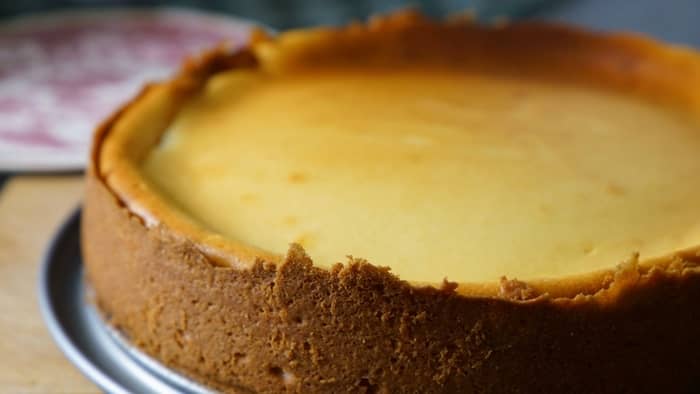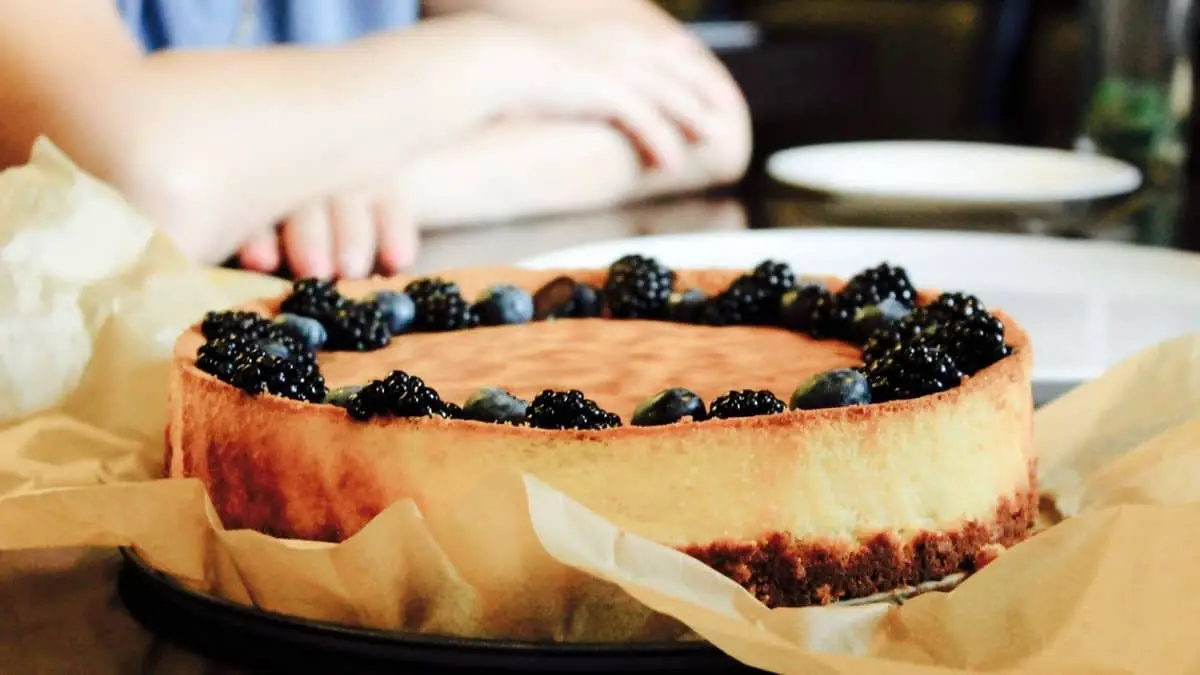Last Updated on July 7, 2022
Cheesecake is a delicious dessert that many home bakers enjoy baking. How to know when cheesecake is done is key if you are planning to make your own. You don’t want to have an over or underbaked cheesecake.
Though cheesecake can be a bit tricky to get right, with the proper steps you can make a delicious dessert. One of the most common mistakes people make when baking a cheesecake is baking it for too long. This can lead to a dry texture that is not creamy like how cheesecake is supposed to be.
How To Know When Cheesecake Is Done
The key to making a delicious cheesecake is baking it for just the right amount of time. This allows you to achieve a smooth, creamy consistency that tastes amazing.
Cheesecakes generally take quite a while to bake. However, the exact time will vary by your oven and the recipe you are using. Fortunately, there are some tricks you can do to make sure your cheesecake is done.

Jiggle it
The best way to tell if a cheesecake is done is to jiggle it. While wearing oven mitts, gently shake your cheesecake.
If only a small circle in the middle slightly jiggles and the cheesecake looks set, then it is done baking. If your cheesecake jiggles a lot when you gently shake it, it needs to bake longer. On the other hand, if there is no jiggle at all then your cheesecake is overbaked.
Instead of using your hands to test the jiggle of the cheesecake, you can also use a wooden spoon. Gently tap the side of your cheesecake pan using your wooden spoon to test the jiggle of your cheesecake.
Look at its color
Another way to check if a cheesecake is done is to look at its color. Your cheesecake should be pale ivory in color with just a slight golden brown color along the edges. If the majority of your cake is golden brown, then it overcooked, if there is no golden brown color, it probably needs to bake a bit longer.
Though this method works well for original-style cheesecake, it does not work as well for chocolate cheesecake, as it is harder to see the coloring. Fortunately, the other methods of checking doneness work just fine for chocolate cheesecake.
Check the temperature
Though this method is not always the best, you can also check the temperature of the cheesecake to see if it is done. The temperature of cheesecake should be between 150-155 degrees Farenheit.
Stick the thermometer in the middle of the cheesecake to see if is done, as this part takes the longest to bake. One downside of this method is that you will be left with a hole in your cheesecake, though you can cover it up with toppings.
Rachael Ray Oven Lovin’ Nonstick Bakeware Springform Baking Pan With Grips
Touch it
You can also use touch as a way to check if your cheesecake is done. Gently touch the center of the cheesecake and if it is firm with a slight give, then it is done.
If you touch the middle and cheesecake is soft or you get batter on your finger, then it needs more time in the oven. On the other hand, if you touch it and it is firm with no give, it might be overcooked. Use caution with this method as your cheesecake will be hot.
Tips For Making A Delicious Cheesecake
Making a cheesecake can be a bit of a challenge, but it is also very rewarding. Fortunately, there are some handy tips that can help you bake the best cheesecake possible.
Make sure all your ingredients are room temperature
When it comes to making a cheesecake, it is very important to make sure all of your ingredients are at room temperature. This is especially important for your cream cheese.
If your ingredients are too cold, they may begin to curdle as a result when being mixed. This can give your cheesecake a lumpy, undesirable texture. By using room temperature ingredients, you can help ensure that your cheesecake will be smooth and creamy.
Use a water bath
Water baths are a great way to prevent your cheesecake from cracking and over-browning. In addition, they will help make your cheesecake smooth and creamy.
To make a water bath, bring a pot of water to a boil. Then place your cheesecake pan within a larger pan in the oven. Then, carefully pour the boiling water into the larger pan, filling it about 1/2-2/3 full with the water.
To help prevent any water from getting into your cheesecake, carefully cover your cheesecake pan with heavy-duty aluminum foil. You can also fill your larger pan with water before placing your cheesecake in it.
Give it time
Cheesecakes can be time-consuming to make, but you don’t want to rush the process. Many recipes will call for the cheesecake to cool inside the oven for one hour once it is done baking. This is an important step as it prevents cracking while it slowly cools down with the oven off and the door slightly cracked.
In addition, don’t open your oven while baking the cheesecake to check if it is done. Heat escaping while it bakes can mess up the consistency of your cheesecake.
A Properly Baked Cheesecake
The best way to test if your cheesecake is done is to gently shake it. If only a small circle in the middle jiggles, then it is all done baking.
Do you have any questions regarding how to know when cheesecake is done? If so, please ask your cheesecake questions down below.
FAQs
What Color Should Cheesecake Be When Done?
When done, a cheesecake should be pale ivory in color. The edge should be slightly golden brown, but not the entire cheesecake.
How Long Should a Cheesecake Take to Set?
After baking, your cheesecake will need to cool for at least one hour. It will then need to be placed in the fridge for at least two to four hours to be fully set.
How Jiggly Should Cheesecake Be When Done?
When done, a small circle of the inside of the cake should jiggly slightly. If there is no jiggle, your cheesecake is likely overbaked.
How Do I Know if My Cheesecake is Undercooked?
If your cheesecake jiggles all throughout, then it is undercooked. In addition, it will be soft to the touch when undercooked.

Ever since she was a young girl, Anna has been a lover of desserts. As an adult, she enjoys
baking a variety of desserts from cakes, cookies, brownies, bread, and more from scratch. She
enjoys sharing her passion for baking with others who also have a sweet tooth. From properly
measuring ingredients to making sure they are the correct temperature, Anna knows the
importance small details can make in baking. She wants to share her experience with others in
hopes they can make the most delicious baked goods. When she’s not busy blogging, Anna
enjoys trying new recipes in the kitchen.


